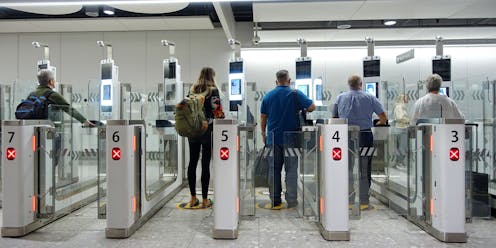
New data shows that the UK has hit a record high net migration number of 606,000. Through it has been central to 13 years of policy and rhetoric, net migration is, in fact, a pretty odd metric that tells us very little about how the UK’s immigration system is functioning.
Net migration is the difference between the number of people entering the country (and expected to stay long term) and the number leaving. So net migration of +1 could be achieved by two people leaving the country and three people moving here, or by ten million people leaving the country and ten million and one moving here. The practical difference between these two scenarios is, of course, huge.
Net migration numbers tell us nothing about what sort of people UK businesses want to employ, how the different migrant groups who are arriving or leaving affect the economy, or the communities they join (or leave). It only really tells us one thing: how migration affects the overall size of the population.
Until 2010, the UK debate generally focused on the number of people arriving – and on the idea that immigration presented a problem. But in January of that year, then opposition leader David Cameron, on a mission to detoxify the Conservative reputation as “the nasty party,” made a key rhetorical shift. He promised to bring net migration – a metric usually only of interest to data nerds and researchers – down to the “tens of thousands”.
This moved the debate away from a focus on immigrants themselves, and instead to a technocratic idea – a number that could be controlled. It introduced the concept that there was a “right amount” of migration to and from the country (less than 100,000), and framed migration as simply a matter of balancing the books.
This was a big PR win in the short term. Journalists could talk about whether the government was achieving a target, rather than the array of more complex metrics that might indicate whether migration policy was delivering economic or social benefits. It arguably also helped Cameron to be elected prime minister.
But the reality was (and still is) that government only has limited control over who comes and goes.
Demands from businesses and universities to allow key people to come to the UK, and from people whose loved ones lived overseas, needed to be catered for. British people and (at the time) EU citizens could come and go as they pleased, and economic or political issues outside the UK were out of government’s control.
A moving target
The coalition years were dominated by this promise to hit the net migration target by the 2015 election. Between 2011 and 2012, Theresa May as home secretary introduced policies to cap skilled non-EU labour migration and close “bogus colleges” and cut abuse of study migration visas.
She also created a minimum income threshold for people bringing a spouse or other family member to live with them, and aimed to “break the link between immigration and settlement”.
But the target was always unrealistic. Within a year, my colleagues and I at the Migration Observatory at the University of Oxford had established that the government’s own impact assessments showed the net migration target could not be met based on the policies that had been introduced. Equally, membership of the EU and free movement meant that the UK had little control over overall levels of migration.
As the 2015 election neared, the magnitude of the failure to meet the target was becoming obvious. A relatively thriving economy and subsequent job creation had helped push net migration over the 300,000 mark. The issue was electoral kryptonite for both Conservatives and Labour, and strengthened Nigel Farage’s then rampant UKIP.
In the end, Cameron secured a surprise majority after a promise to hold a referendum on EU membership. The party reiterated its promise to hit the net migration target, now referred to as an “ambition”, while Cameron campaigned to remain in the EU.
But promises to cut migration while staying committed to free movement began to look increasingly mealymouthed. Director of the Vote Leave campaign Dominic Cummings attributed victory in the Brexit campaign to the focus on migration.
It also led Cameron to resign. And when Theresa May took over as prime minister, her administration continued to commit itself to the net migration target, including it in her election manifesto.
This time, it was economics rather than policy that pushed net numbers down. The referendum dented the confidence of the international finance markets, and the pound plummeted in value against the Euro, the Zloty and other currencies.
Migrants in the UK, particularly those sending money home to their families, were earning less. Meanwhile the Eurozone was recovering from a years-long slump, with job creation in other EU member states. This combination is thought to be the main driver of a sharp fall in EU net migration to the UK, particularly from the new member states.
Caught in their own net
When Boris Johnson stepped in as prime minister, the net migration target was killed off, to be replaced by a somewhat vague new concept: the “Australian-style points based system”.
He continued to suggest this would deliver lower numbers, but with attention elsewhere and net migration lower than before the referendum, nobody seemed keen for a return to Cameron’s “balancing the books”.
Ultimately, the net migration target was hit by accident. It turned out that all that was needed was a global pandemic.
But Johnson’s “have your cake and eat it” post-Brexit policymaking – which has continued under Rishi Sunak – planted the seeds for a new net migration panic.
Under Johnson and Sunak, vague promises to cut net migration have been coupled with a significant liberalisation of the immigration system, most notably in the form of humanitarian visa routes for people leaving Ukraine and Hong Kong. These have made up a significant share of the record-high increase reflected in the latest numbers.
Additionally, relaxations of visa rules for non-EU workers, such as making care workers eligible for long-term work visas and reintroducing post-study work for international students, received significant take-up.
The public has largely supported many of these policies, and concerns about migration (apart from small boat arrivals, which contribute only a small percentage of net migration) have been relatively low for some time.

But despite this, the media and policy response to the 606,000 number suggests that once again these numbers – though likely to be temporary – are causing serious concerns.
Conservatives still appear to regard control of migration as a key policy area on which they can win against Labour. But the party may wish that David Cameron had never opened Pandora’s box with his simplistic target.
Indeed, Rishi Sunak’s response has been to sidestep targets, while reiterating that the number is “too high”.
Now that the public has been introduced to the problematic concept of the “right amount” of net migration, the government may simply have to accept that it has been caught in its own net.
Rob McNeil has recently received funding from the Economic and Social Research Council, and will shortly be starting work on a project that is funded by the Engineering and Physical Sciences Research Council. He is also a trustee of the Work Rights Centre, which supports disadvantaged Britons' and migrants' access to employment justice.
This article was originally published on The Conversation. Read the original article.







